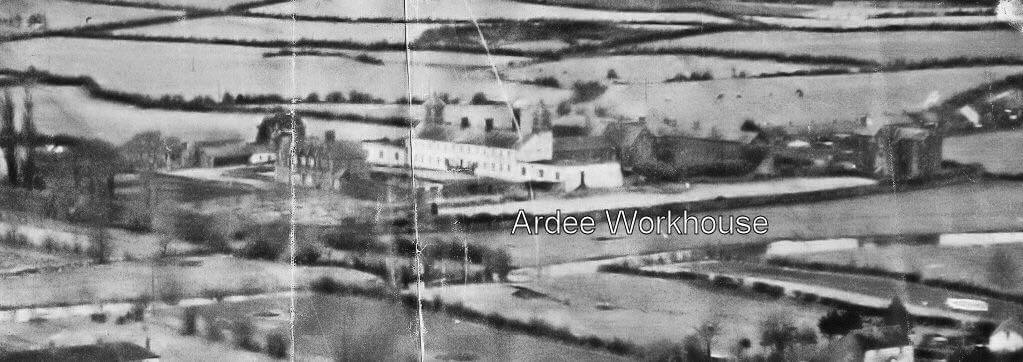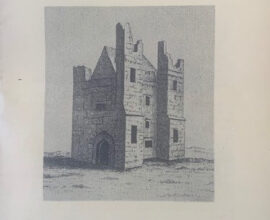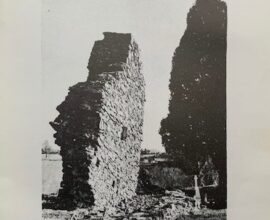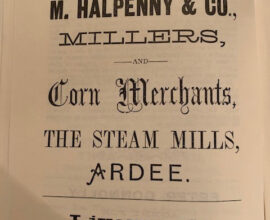Victorian Welfare and Ardee Workhouse
by Kevin McKenny
In 1838, to deal with the ever-growing poverty of the poorer classes in Ireland, a Poor Law Act was enacted, and it remained in existence until 1923. The main tenets of this Act were that no outside relief would be given and any relief that was given had to be earned. To achieve this the country was divided into Poor Law Unions and each was to have its own Union Workhouse. The poorer classes had to enter these Workhouses and work if they wanted food. In County Louth there were three such Unions, Dundalk, Drogheda and Ardee. The Ardee Union encompassed almost all of the mid Louth Parishes and the Workhouse was built in the town itself. Each Union was governed by a Board of Guardians made up of landowning men from each of the parishes attached to the Union. Their responsibilities were to oversee the running of the Workhouse and the collection of special taxes that were enacted where people had to pay Rates based on the size of their landholding or house.
In accordance with Section 35 of the Poor Law Act, these Guardians caused to be
built, on a 5 acre site, a Workhouse, designed by George Wilkinson, capable of
holding 600 inmates. The cost of the building was £5,175 with a further cost of
£1,975 for fixtures and fittings. A Fever Hospital was also erected during the
Famine capable of holding up to 40 patients. Whereas the design and layout of
Workhouses across Ireland and the British Isles were all quite similar it would
appear that the Ardee Workhouse was unique in that it was the only one that had
an interdenominational Church included in the build. It was sited between the
dining room and the infirmary building (see map and two images of the
Workhouse)
The Workhouse Opens

On 30th May 1842 the first of many inmates (described as the destitute poor) were admitted. Initially the numbers remained between 200 to 600 but, as the potato crops failed from 1845 to 1849, causing the Great Famine, the numbers shot up to over 1,000 which, as we shall see below, was to lead to many health issues and deaths in the Ardee Workhouse.
One of the main responsibilities of the Board of Guardians, apart from overseeing the Rate Collectors, was the purchase of supplies for the Workhouse. This process dominates the Minute Books. We learn from there that tons upon tons of wheat, rice, Indian corn and other supplies were regularly delivered to the Workhouse. In addition to this both milk and buttermilk were delivered almost daily. In obtaining these supplies the Board inevitably favoured local merchants or landed gentry. This practice ensured the continued prosperity of Ardee’s merchant and farming community and helped to lessen the effects of the Famine in the Ardee area, at least for some.
People were generally admitted to the Workhouse as a family group. Abandoned
children and old people were also admitted after they had been left at the
Workhouse gate by struggling families. The inmates were then deloused and
dressed in Union clothing. Men’s jackets were made from frieze while their
trousers were corduroy. Women’s frocks were made from wool or calico;
petticoats were from flannel.
Family Separations

Adults and children, over the age of 16, were immediately separated. Infants
under two could stay with their mothers but, on reaching their second birthday,
they were taken from their mothers and placed in the children’s section which
also included a school area.
The daily timetable for inmates was as follows;
Work 7.00am to 8.45am
Breakfast 9.00am to 10.00am
Work 10.00am to 1.00pm
Dinner 1.30pm
Work 3.00pm to 6.pm
Supper 7.00pm
Locked in Dorm 8.00pm
The food that was given out during meal times was basic and the portions were small. (see photo of the food that was available)
Initially the inmates were employed in breaking stones in the yards with each inmate required to break a ton of rocks each day. In the early days this was considered the only occupation suitable for Workhouse inmates. Later, in the 19th century, industrial training was given. Women were taught spinning, sowing and laundering while men were taught shoemaking, tailoring and weaving.
Discipline was quite strict. The procedure was for first offenders to be brought before the Board of Guardians where a caution, or a sentence to a probationary ward would be issued. If a person re-offended, they were brought in front of the Magistrate who was authorised to dismiss them from the Workhouse, which dismissal excluded them from receiving any further relief under the Poor Law system.
Official Records
The minute books of the Board of Guardians (which are in the Louth County Archives) are a mine of information. (see sample image from the Minute Book) Among other things, they allude to the fact that inmates of the House were put forward for emigration to other countries. This was seen as a means to fix the problem of overcrowding, but it is a pity that the chosen inmates were not given the choice as they were literally gathered up and sent abroad, initially to Australia and then to Canada.
In April 1849, for example, the Minute Book of the Ardee Workhouse, lists 22
woman who were selected to be sent to Australia. After the Medical Officer gave
them a clean bill of health, they were escorted to Drogheda where they then
travelled by train to Dublin and from there to Plymouth in England. They were
put on board a ship on 17th August 1849 bound for Australia. Their names were;
Maria Bingham, Ellen Boyle, Anna Carney, Mary Carolan. Mary Casey, Mary
Coleman, Biddy Conlon, Mary Daly, Anne Grey, Jane Gooden, Marty Hanratty, Jane
Jones, Margaret Jones, Biddy Magrane, Isabella Maguire, Alice McMahon, Ann
McQuillan, Mary Meade, Bridget Murphy, Hannah Reilly, Mary Thornton, Anne
McQuillan.
Each of the girls were provided with the following items of clothing and other
supplies
6 shifts 6 stockings
2 short wrappers 2 night wrappers
2 pairs of shoes 2 gowns
2 flannel petticoats 2 cotton petticoats
2 neck handkerchiefs 1 stout worsted shawl and cloak
3 pocket handkerchiefs 2 linen collars
1 bonnet 1 pair of mittens
In addition to these clothes each were also given 2 towels, 2 pounds of soap,
combs and brushes, needle and thread. To store all these, they were also given
1 wooden box two-foot-long, 14inchs wide and 14 inches deep with lock and key.
These were to be painted with the girl’s name on the front. Finally, they were
each given a bible depending on their religious denomination.
Forced Emigration
This was the first of many forced emigration schemes where people from the Workhouse, usually girls, orphans and widows, were taken from their homeland and sent to Australia and Canada. They had no say in the matter. From 1849 onwards the Board of Guardians preferred Quebec as their destination of choice. Upwards of 1,000 children from the Ardee Workhouse were landed there and had to go through the terrible experience of the infamous Grosse Ile reception centre, which all emigrants to Canada had to endure. There still exists lists compiled by both the Protestant and Catholic Church authorities for Quebec and Montreal. The lists preserved by the Grey Nuns of Quebec contains the names of those from the Ardee Workhouse.
Whereas the forced emigration schemes organised by the Board of Guardians literally dumped people on foreign shores with no means of support there were other schemes organised by the renowned philanthropist, Vere Foster, from Glyde Court in Tallanstown. He rescued many women from the Ardee Workhouse by assisting them to emigrate to the United States of America. Unlike the Board of Guardian’s scheme, he travelled with the female emigrants and arranged for employment for them when they reached their new world.
For example, in 1855 Vere left Ardee with 75 women, most of them from the
Workhouse. After putting them aboard the sailing ship, the City of Mobile, Vere
himself sailed to New York by steam in order to complete plans for their
reception. Vere met the ship on its arrival in New York but found, that despite
his warnings, four of the women had been taken to work in a brothel by the
sailors who had promised them great wealth. He accompanied the remaining 116
women into the interior. At various stopping points Vere and his party were met
by Parish Priests or persons of Irish descent, who took the women into care
until positions were found for them. On one of these stopovers Vere and the
remaining Ardee women found themselves at Springfield where, ‘a distinguished
lawyer had most kindly offered to give a home to some of the women’. This was
no less a person than Abraham Lincoln and Vere and his party found themselves
staying overnight with the future President and his wife.
The names and ages of the 75 women who left Ardee for America in 1855
Barton Alice, 20 Bellew Maria, 16 Brady Anna, 16
Brady Catherine, 16 Brady Mary, 20 Brady Rose, 18
Byrnes Catherine, 20 Byrnes Ellen, 18 Campbell Anne,16
Campbell Mary, 19 Campbell Mary, 16 Carney Bridget, 22
Carroll Mary, 19 Carolan Catherine,18 Carry Biddy, 16
Clarke Mary, 25 Coleman Margaret, 16 Condra Anna, 22
Conlon Anne, 17 Connor Mary, 16 Creaton Catherine, –
Cummerford Mary,21 Cunningham A 20 Cunningham Bridget,20
Drumgoole Margaret,20 Duffy Anne, 18 ` Duffy Anne, 18
Duffy Elizabeth, 20 Durnin Mary, 16 Flanagan Ellen,18
Gaherty Mary, 16 Gartland J. 25 Gartland Mary, 22
Green Mary, 17 Grimes Bessy, 16 Grimes Catherine, 17
Hand Jane, 14 Kernan Ellen, 17 Lamb Mary, 20
Mackle Margaret,18 Malone Margaret, 16 Malone Mary, 20
Marron Rose, 20 Mathews Margaret, 37 Mathews Margaret, 14
Mathews Mary, 20 McArdle Margaret, 17 McCanna Margaret, 21
McCormack Catherine, 20 McDonald Mary, 21 McIntegart Eliza, 16
McLean Catherine, 18 ` McNeill Anne, 14 Meade Anna, 17
Murphy Bridget, 23 Murphy Jane, 21 Murphy J 21
Murphy Mary, 22 O’Brien Catherine, 16 Reilly Margaret, 17
Reynolds Essy, 18 Rogers Anne, 26 Sanders I, 22
Shallcross Henrietta, 6 Sheridan P, 26 Skelly Catherine, 18
Smith Catherine, 16 Smith Kate 20 Taaffe Anna, 15
Tiernan Jane, 18 Victory Anne, –
Overcrowding in the Workhouse
In late November 1846, the Workhouse was full, so the Board investigated the possibilities of admitting a greater number than the building was originally built to accommodate. In late 1846 the Clerk was ordered to investigate if there were any buildings in the town that might serve as additional dormitories. Th building decided upon was the Malt House (Bridge Street) which they leased for £1 per month. A large number of boys accompanied by the Porter and two trustees were removed to the Malt house. It was not long before this building, which was only supposed to support 40 inmates, had over 400 inmates housed in it.
Fever and other diseases claimed the lives of over 1,000 inmates between 1846
and 1847. All of these were interred in the yards outside the Workhouse Church.
People were being buried there in quicklime graves until 24th August 1847 when
the Board were ordered to procure another burial ground and the place decided
upon was the field around the Fever Hospital. These are marked G in the attached
map of the Ardee Workhouse. When these areas quickly filled up with the corpses
of the dead it was then decided to bring the corpses by horse and cart up
Stoney Lane and past Balapousta until it reached Smarmore where an unknown
number of people were buried in the small graveyard there.
Burial Site of the Unknown Dead

The unknown dead, from Ardee Workhouse, buried in Smarmore, created a mystery when, sometime in May 2016, a mysterious large headstone appeared there (see photo attached). Nobody knows who put it there as nobody claimed it and no permission was sought from Louth County Council who were the owners of the Smarmore graveyard.
The headstone is titled Smearamair and is prefaced by the Gaelic; ‘Cad ta
deanta agat arsa an Tiarna Eist! Ta guth fhuil do dhearthar ag glaoch orm as an
talamh.’
This translates as ‘What have you said, Lord! The blood of your brother is
calling me from the ground’.
The inscription on the headstone reads;
‘Sacred to the memory of the starvelings of 1845-1850 interred here including
in cartloads from Ardee workhouse when British regiments including the 6th
Dragoon guards and 17th Lancers removed livestock, grains, meal etc from this
parish.’
Somebody went to a lot of trouble and expense to honour and remember the dead
from the Ardee Workhouse. I salute that person as they have done, in one single
gesture, what the rest of us Ardonians have not done in 150 years and that is
to remember those that died in the horrendous conditions of the Ardee
Workhouse.
The Year of 1847
During the Great Famine of 1845 to 1849 the year 1847 was by far the worst in disease and deaths. This led to it being called Black ‘47. In the Ardee Workhouse that year was also the worst in the numbers of the dead and dying. The Chief Medical Office for the Workhouse was Doctor Edward McArdle. At the end of 1846 he indicated that there was a ‘marked increase in admissions to the house during the year and more than half of those admitted were sick. The death rate was very great, but this can be accounted for by the large numbers of those entering the Workhouse who were either sick or very old. Additionally, the prevalence of dysentery was also a mitigating factor.
The sharp rise in the number of fever patients that came from within the
Workhouse was caused by the state of the people being admitted who infected
others. Additionally, the very crowded state of the house was also a contributing
factor to the large incidence of fever among the inmates’.
Certain Death
He concluded by saying ‘I think we have cause for congratulations that we have escaped so lightly this year, although we might not be so lucky in the coming years’.
This prophecy became real in the year 1847. Doctor McArdle left a detailed report for that year. These figures do not include the number of people who died in the Fever Hospital which can be assumed to be much higher. The conditions within it must have been horrendous. Originally built for 40 patients it housed hundreds in crowded conditions throughout 1847. Such was the death rate within it that year that it was set up in a serious of wards next to each other and, as patients health got worse they were moved along these rooms until they entered the Death Ward. When one entered here there was only one exit from this room and that was out the window and down a chute to a waiting cart to take the corpse to Smarmore Graveyard.
Ardee Workhouse Infirmary Medical Officers Report for year 25th March 1847 to
25th March 1848, 92 patients remained in the Infirmary from the previous year.
A further 1,636 people were admitted to the Infirmary during this time and 18
were born there (making a total of 1,746 patients in the Infirmary for this
period). 1,215 of these were cured and returned to the dormitories. 338 died,
141 were sent to the Fever Hospital and 152 remained under treatment on the
date of the report.
Causes of death in Ardee Workhouse Infirmary in this period.
Disease of the brain and nervous system. 17
Disease of the lungs and heart. 70
Disease of the digestive or urinary caused mainly by dysentery. 138
Disease caused by defective nutrition. 54
Very soon after admission. 26
Old age and decay 30
Cancer 3
The ages at which these
deaths occurred
At and under 1 year old 21
Over 1 and under 10 95
10 and under 20 48
20 and under 30 15
30 and under 40 14
40 and under 50 20
50 and under 60 21
60 and under 70 39
70 and under 80 37
80 and under 90 26
90 and under 100 2
The Workhouse in Ardee continued to admit the poor and the destitute until it
finally closed in 1922 when it then became the County Home and later the Ardee
Vocational (Technical) School. I attended that school myself for several years
and recall finding many books, ledgers and other documents relating to the
Workhouse. They were literally discarded in a corner of one of the air towers.
These records are now in the County Archives Dundalk





this is a very informative piece! I’m wondering if there is a resource to find out what might have happened to an infant born in 1867 to an inmate of the workhouse. I know the name and date of birth, and mother’s name. Thank you in advance!
Hi Margaret,
Have a look through the National Archives records. See link below. You can search through 1821 to 1911.
http://www.census.nationalarchives.ie/search/
Paddy
Thanks for your efforts, most of your information is valuable and most informative, however;
1. The inscription on the Memorial Stone (translated) actually means something more like;
“What have you done, says the Lord
Listen! The voice of your brother’s blood is calling to me from the ground”
2. There was no famine in Ireland from 1845 to 1850, 70 shiploads of food was escorted at gunpoint out of Ireland to Britain each day by over 100,000 armed Crown enforcers incld 67,000 troops plus yeomanry, militias and police, don’t forget that they all needed to be fed plus all of the wealthy people.
As a consequence, in excess of 5 million poor people in Ireland died from mainly ‘starvation’ and related diseases like typhus & cholera, and hypothermia and related events like coffin ships, executions, torture, suicide etc. .! Its just so un-intelligent and horribly disrespectful to say that these people simply died of famine when there was so much food available. All of the ship manifests are available at Kew, London. Those starvelings were actually Crown subjects.!
3. For Ms Margaret Fetters assistance above, please visit this website for lots of information about details of people in Ireland from 1821 to 1911. http://www.census.nationalarchives.ie/search/
The words on the stone are a quotation from the book of Genesis (4:1-15) when the lord asks Cain what he has done to his brother Abel: ’
‘Cad tá déanta agat? arsa an Tiarna.
‘Tá guth fhuil do dhearthár ag glaoch orm as an talamh.
Beidh mallacht ort feasta agus tú ar díbirt ón talamh seo a d’oscail a
bhéal agus a ghlac fuil do dhearthár ó do láimh.